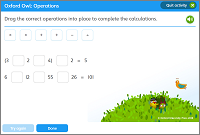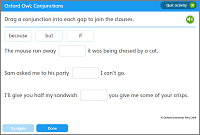Jargon buster: 'Blending' to 'conjunctions'

A | B–C | D–G | H–L | M | N–O | P | Q–R | S | T–Z
A | B | C | D | E | F | G | H | I | J | K | L | M | N | O | P | Q | R | S | T | U | V | W | X | Y | Z
B
Blending
To say the individual sounds that make up a word and blend them together to hear the whole word for reading (for example, 's-a-t' becomes 'sat'). We say you blend to read and segment to spell.
Video: How to blend sounds to read words
BODMAS
Mathematical operations can include brackets, orders (root and square numbers), division, multiplication, addition, and subtraction. 'BODMAS' is a way of remembering the order these operations should be carried out within a calculation: first anything inside brackets, then any squares or roots, then any division and multiplication, and finally any addition and subtraction, working from left to right.
For example:
22 × 5 + (10 - 3) = ?
We complete everything in brackets first:
22 × 5 + (10 - 3) = ?
10 - 3 = 7
22 × 5 + 7 = ?
Next, we complete any 'order' calculations (squares or roots):
22 × 5 + 7 = ?
22 = 2 × 2 = 4
4 × 5 + 7 = ?
Next, we complete any division or multiplication:
4 × 5 + 7 = ?
4 × 5 = 20
20 + 7 = ?
Finally, we complete any addition or subtraction:
20 + 7 = ?
20 + 7 = 27
So, 22 × 5 + (10 - 3) = 27
Video: What is BODMAS?
Activity: Problem solving: Operations (Age 9–10)

Book Bands
A system of grouping books in bands of colour to represent different levels of reading difficulty. Read more about book bands and reading levels >.
Brackets ( )
Used to separate a word or phrase that has been added to a sentence as an explanation or afterthought. If you take out the word or phrase between the brackets, the sentence should still make sense.
For example: My birthday cake was chocolate (which is my absolute favourite) with chocolate icing and chocolate buttons on top as well.
Bullet points
Used to organise a list of points in order to make it clear. The text introducing the list of bullet points should end with a colon.
For example: We gave the following reasons for wanting to have a party:
- It was our last year in primary school.
- We wanted to say goodbye to our teachers.
- We had worked hard all year.
C
Catch Up
It is often used as a term for an intervention programme but it is also a not-for-profit organisation that provides training techniques to support teachers to help children identified as underachieving: www.catchup.org.
Chunking
Chunking is sometimes used as a way of estimating or checking division calculations. Using multiples of the number that the total has to be divided by breaks down the calculation into sizeable 'chunks' that are subtracted from the total. A first step in a calculation such as 615 ÷ 20 could involve subtracting 'chunks' of multiples of 20, one step at a time.
For example: 615 – 200 – 200 – 200 = 15, so the answer to 615 ÷ 20 must be 30 (multiply 10 × 3 steps), plus a remainder.
Video: How to do division by chunking
Clause
A phrase which has a verb as its head, or key word. The other words add meaning to the verb.
Video: What are phrases and clauses?
Main clause: A clause that can be used on its own as a sentence.
For example: The bird pecked the apple. It flew away.
Main clauses can be joined with coordinating conjunctions such as 'and', 'but' and 'or'.
For example: The bird pecked the apple and it flew away.
Subordinate clause: A subordinate clause helps to give more meaning to the main clause. It cannot exist on its own as it is not a complete sentence. A subordinate clause often starts with a subordinating conjunction such as 'although', 'because', 'before', 'if', 'since' or 'when'.
For example: The bird pecked the apple before it flew away.
Video: What is a subordinate clause?
Relative clause: A type of subordinate clause. It is connected to the main clause by a relative pronoun such as 'that', 'which', 'who', 'whom' or 'whose'.
For example: I enjoyed the film that we saw last night.
Video: Learn about phrases and clauses
Cohesion
The ways in which the writer makes the different parts of a text link together, for example, by grouping sentences together in paragraphs using particular words and phrases to link ideas.
Cohesive device
A word or phrase that shows how the different parts of a text link together.
Use determiners and pronouns to link back to other words:
For example: Mr Smith came in with his dog. The dog and he were both old.
Use a conjunction to link words or groups of words within a sentence.
For example: Mr Smith and his dog were both old.
Use adverbs and adverbials to link between sentences.
For example: I saw a robin in the garden. Later, I saw a green bird.
Use ellipsis when a word or phrase has already been used and does not need to be repeated again.
For example: ‘What do you want to eat?’ ‘A biscuit.’ [‘I want to eat’ has been missed out.]
Video: What are cohesive devices?
Colon :
A colon can be used to introduce a list.
For example: I love the following foods: apples, seeds, grapes and nuts.
A colon can be used to introduce examples or explanations. The words after the colon give more information about what comes before it.
For example: The bird eats lots of snacks: he needs lots of energy for flying.
You do not need to use a capital letter for the word that comes after a colon, unless it is a proper noun or the word 'I'.
Colour coded
Books are sometimes colour coded in schools so that children choose a book from a similar level. The colours represent different levels of reading difficulty. Read more about book bands and reading levels >
Comma ,
A comma can be used to separate items in a list.
For example: I like peas, carrots, beans and pizza.
Some texts use the serial, or Oxford, comma after the penultimate item in a list.
For example: I ate an orange, an apple, and raspberries.
A comma can be used to change the meaning of a sentence.
For example: I told him, honestly. I told him honestly.
A comma can be used to avoid ambiguity.
For example: I’d like some jelly and ice cream for my sister. I’d like some jelly, and ice cream for my sister.
A comma can be used before a clause starting with 'or', 'and' or 'but'.
For example: Did you paint this picture yourself, or did someone help you?
A comma is used after a subordinate clause at the start of a sentence.
For example: If we’re really quiet, we won’t disturb Grandad.
A comma is also usually used after a fronted adverbial.
For example: With a shake, the dog dried itself off.
A comma is used to separate the name of the person being spoken to from the rest of the sentence.
For example: Kids, dinner’s ready!
Command
A sentence which gives an order or instruction.
For example: Take this food away!
A sentence that is a command or instruction is usually in the imperative, with the verb first. An exclamation mark can also come at the end of a command.
Common factor
A common factor is a number that can be divided into two different numbers.
For example: The common factors of 12 and 18 are 1, 2, 3 and 6 as these are the factors that are common to both numbers.
Compound
A compound word is made up of two words joined together. 'Bedroom' and 'football' are compound words.
Comprehension
The understanding of a text; at its simplest this may be an understanding of what the text is about (for example, the story is about a pumpkin) and at its most sophisticated, it is an understanding of what lies beneath a text (for example, the author's experience, historical context, themes and so on) which is often referred to as the deeper levels of meaning, inferential comprehension or higher order reading skills.
Video: What is comprehension?
Video: Supporting your child's reading comprehension
Activity: Comprehension (Age 10–11

Conjunction
A conjunction links words or groups of words within a sentence.
For example: A cat crept up the tree as the bird pecked the apple and ate it noisily.
Coordinating conjunction: A coordinating conjunction joins groups of words which are of the same importance in the sentence.
For example: bread and cheese; Jack and Jill.
Main clauses can be joined with coordinating conjunctions such as 'or', 'and' or 'but'.
Subordinating conjunction: A subordinating conjunction introduces a subordinate clause, such as 'after', 'although', 'as', 'because', 'before', 'if', 'since', 'when' and 'while'.
For example: The cat watched the bird quietly because he didn’t want to scare it away.
Activity: Conjunctions

Consonant
Vowels are sounds represented by the letters 'a', 'e', 'i', 'o', 'u' and sometimes 'y'. All other sounds are called consonants and are represented by the other letters in the alphabet, which are called consonant letters.
A | B–C | D–G | H–L | M | N–O | P | Q–R | S | T–Z
A | B | C | D | E | F | G | H | I | J | K | L | M | N | O | P | Q | R | S | T | U | V | W | X | Y | Z